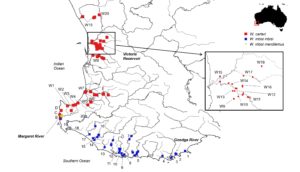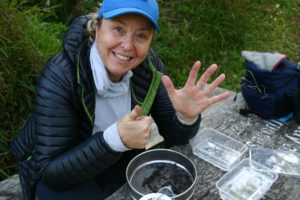
Genetic techniques have helped uncover a new threatened species of freshwater mussel in southern Western Australia and redefine the range of existing species.

Published in , the collaboration with researchers from Griffith University, the Western Australian Museum, the University of Western Australia and the University of Nottingham (UK), formally described a new species of freshwater mussel and two subspecies from southern coastal WA.
“This is only the second study to describe a new species of freshwater mussel in Australia since the 1950s,” said lead author , a research fellow at the .
“And it’s the first study in Australia to formally describe a new species of freshwater mussel using both genetic and morphological comparative techniques.”
Carter’s freshwater mussel, Westralunio carteri, listed as vulnerable on the IUCN Red List and under Australian legislation and limited to Australia’s southwest, has long been considered the only Westralunio species in Australia.
However, this research confirms the existence of three evolutionary lineages of this freshwater mussel, the original Westralunio carteri from western coastal drainages and two significantly smaller and less elongated subspecies: Westralunio inbisi inbisi from southern coastal drainages, and Westralunio inbisi meridiemus from the southwestern corner.

“In order to protect a threatened species, we need to have a scientific name for it to be recognised under Australian state and Commonwealth legislation,” Dr Klunzinger said.
“More simply, in order to protect a species, we need to give it a name.”
The name ‘inbisi’ was selected by the authors and approved by the WA Museum Aboriginal Advisory Committee.
“The name is derived from ‘inbi’, a word from Indigenous Nyungar language spoken in the region translating to freshwater mussel,” said Dr Lisa Kirkendale, Curator of Molluscs at the WA Museum.
“It is important to remember that freshwater mussels are more than just food or fishing bait,” stated Dr Barbara Stewart, Senior Lecturer at the University of Western Australia. “They are important for keeping our waterways clean and healthy.”

The southwest coast of Western Australia where these species inhabit is affected by climate change and dryland salinity. Clearing trees for agriculture resulted in a rising groundwater table which dissolved salts stored in the soil. Run-off of this salty water into rivers is toxic to freshwater mussels.
“In addition to salinity, climate change is resulting in drastic declines in rainfall and increasing temperatures which further threaten each species,” Dr Klunzinger said.

“Recognition of this new freshwater mussel species profoundly reduces the range of Westralunio carteri northward and introduces new species with restricted distributions in the South and Southwest.
“For this reason, we are calling for new threatened species classifications for both the Westralunio carteri and Westralunio inbisi species of freshwater mussels in Western Australia.”
The use of these combined techniques is likely to reveal new mussel species and diminished ranges of existing species in other parts of Australia and elsewhere around the world.








